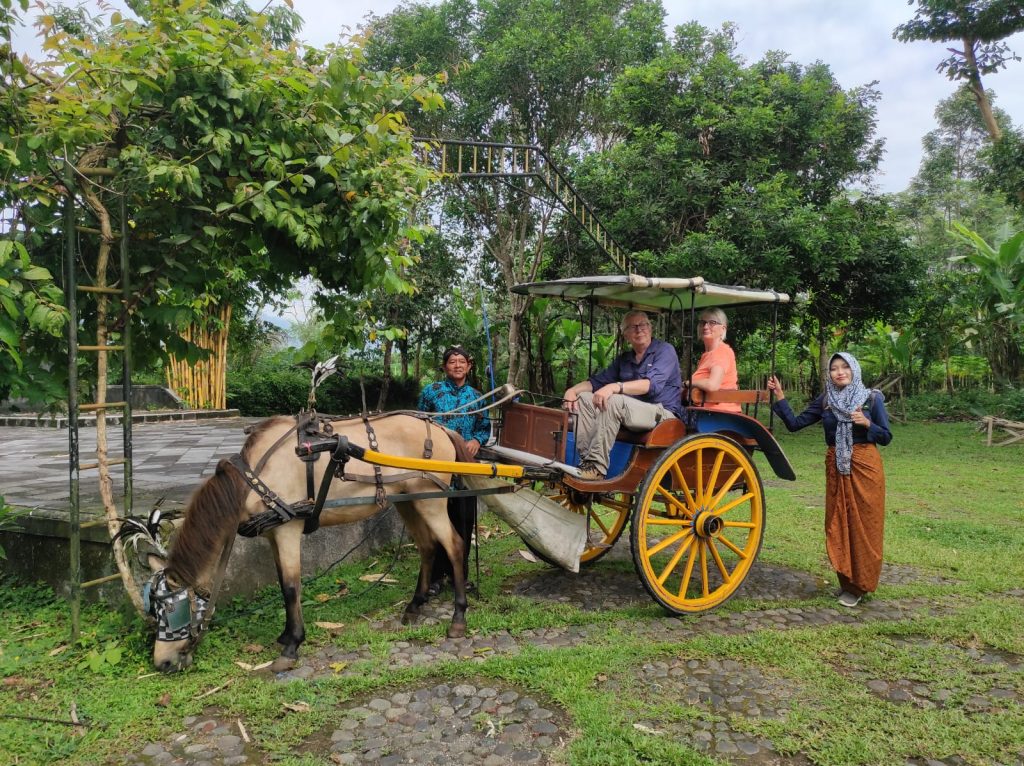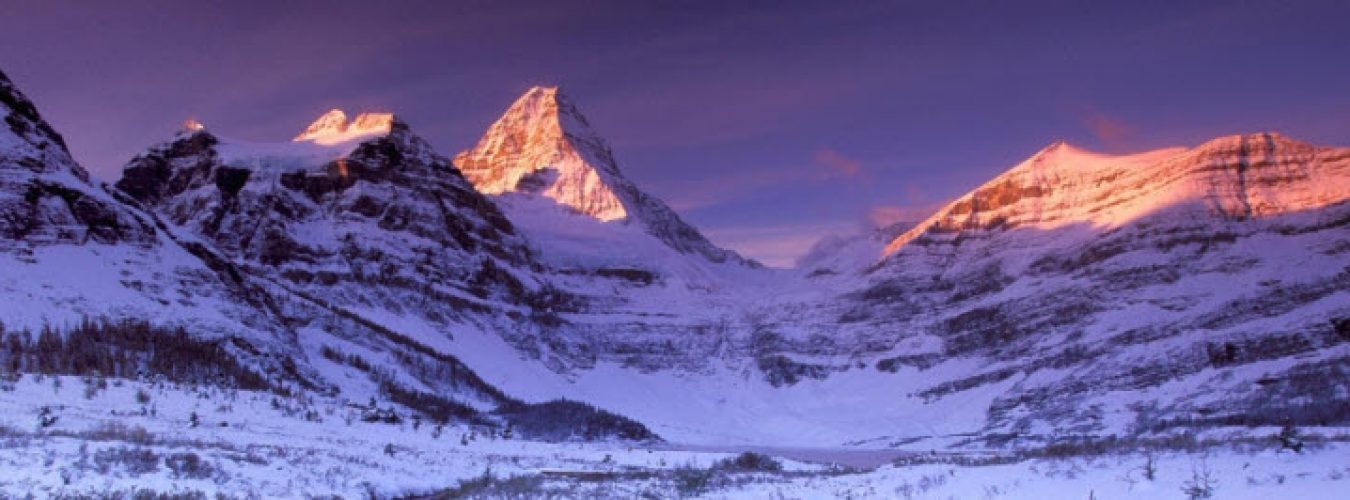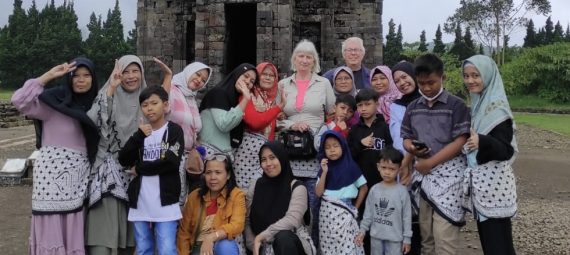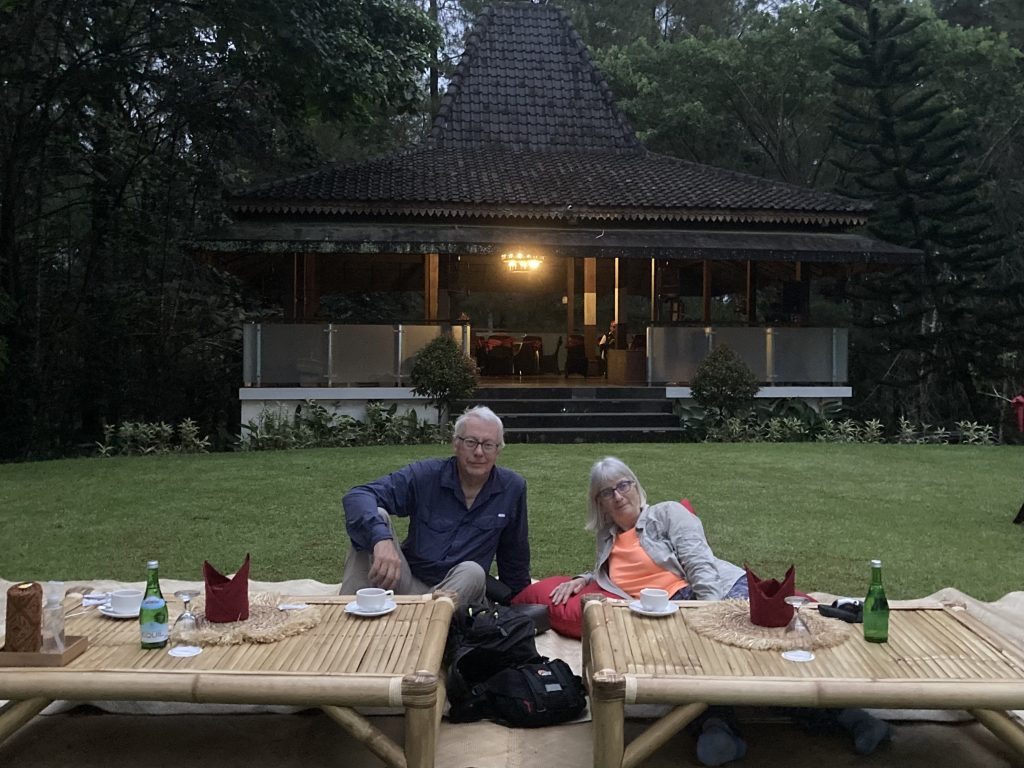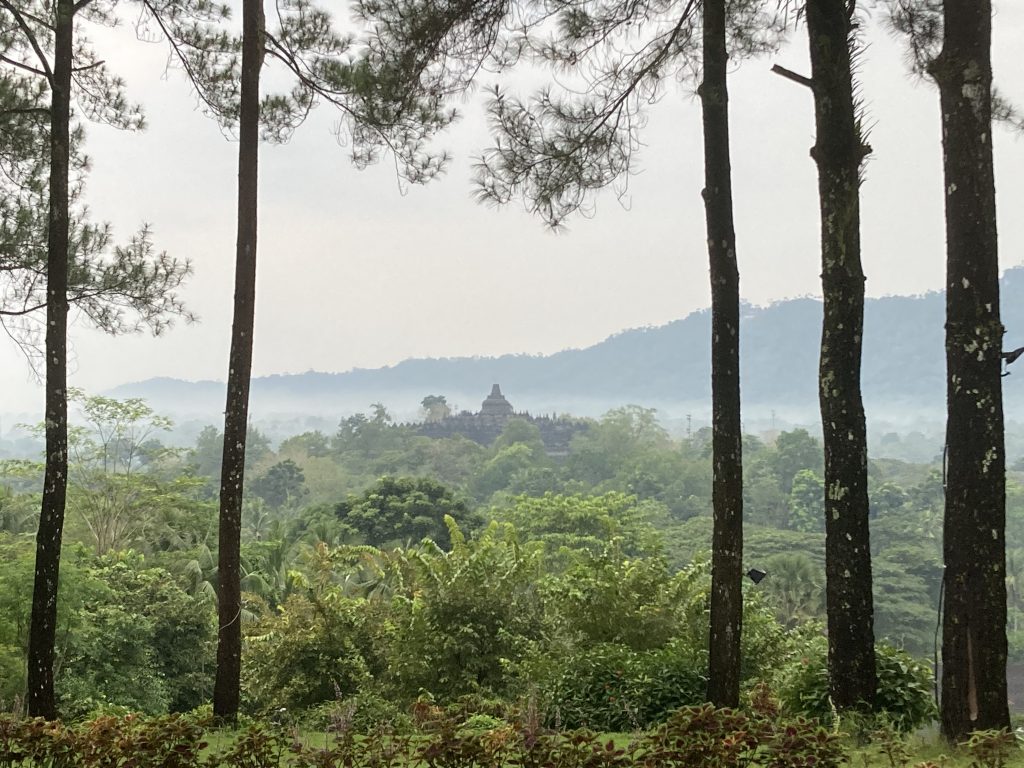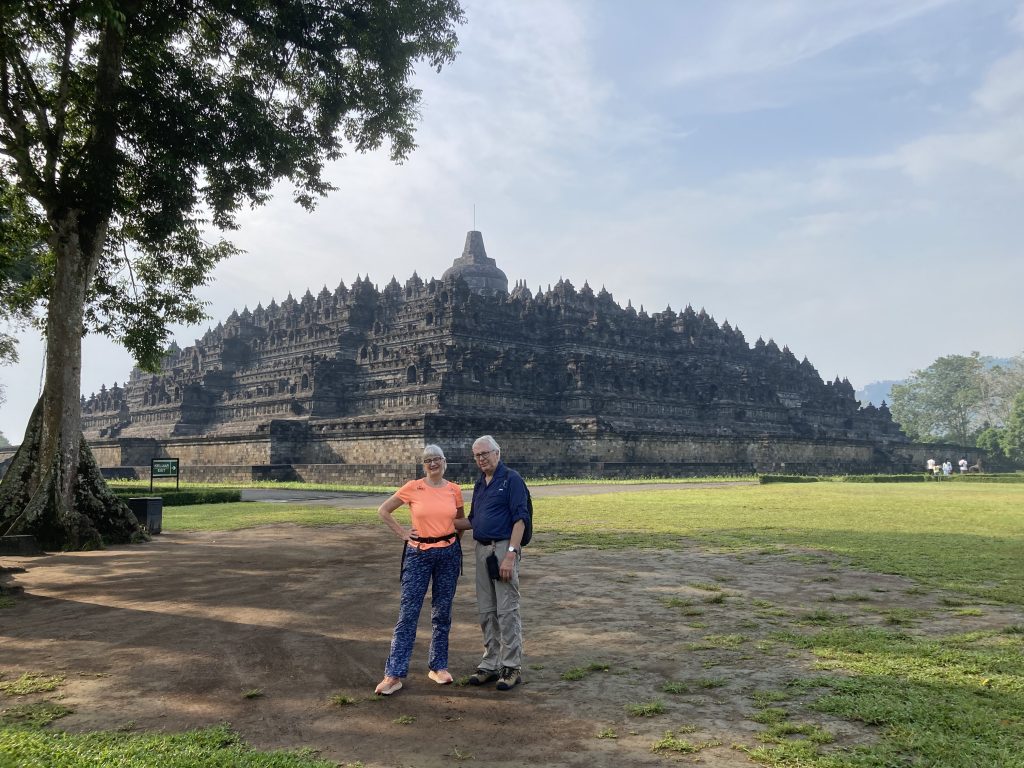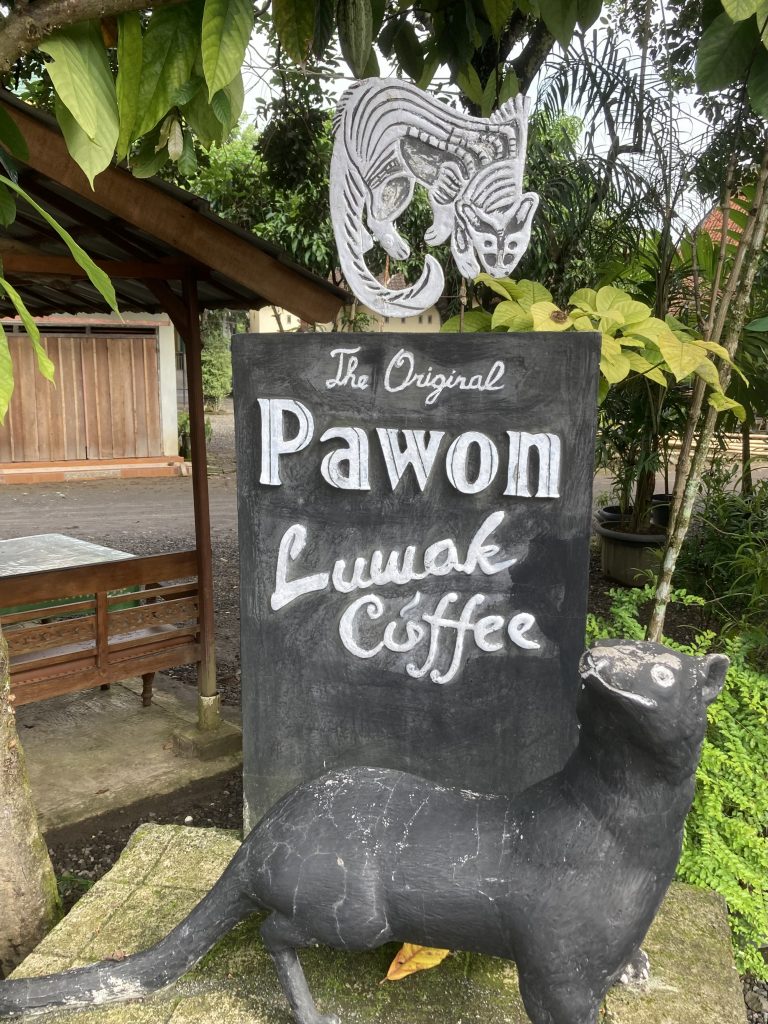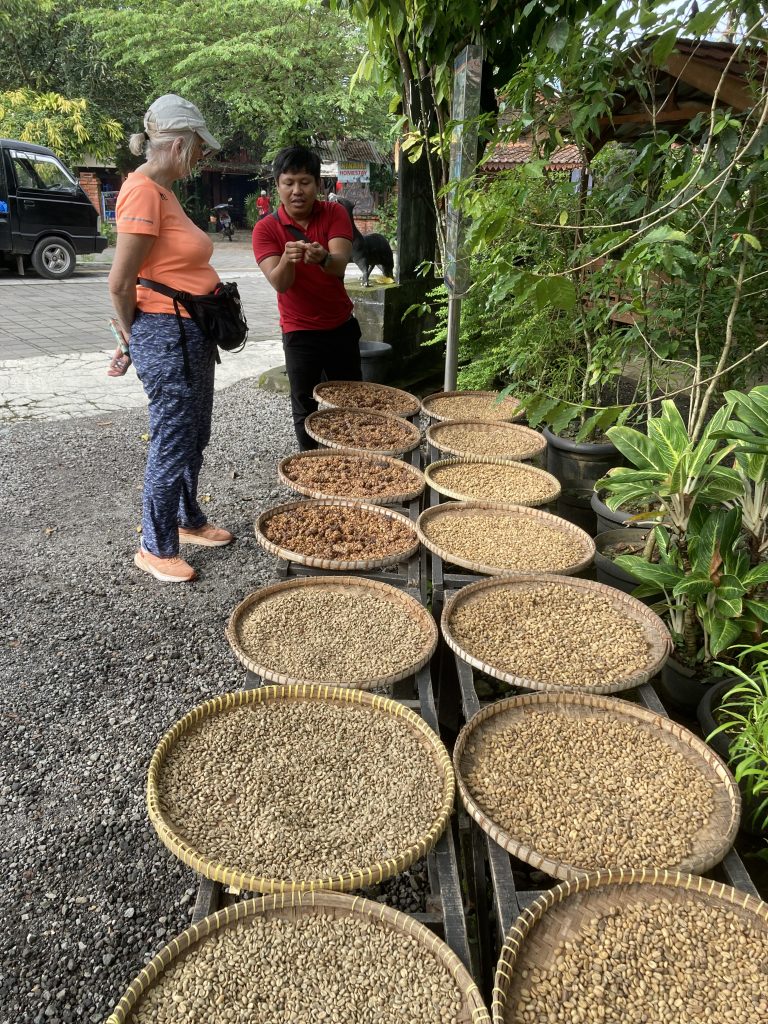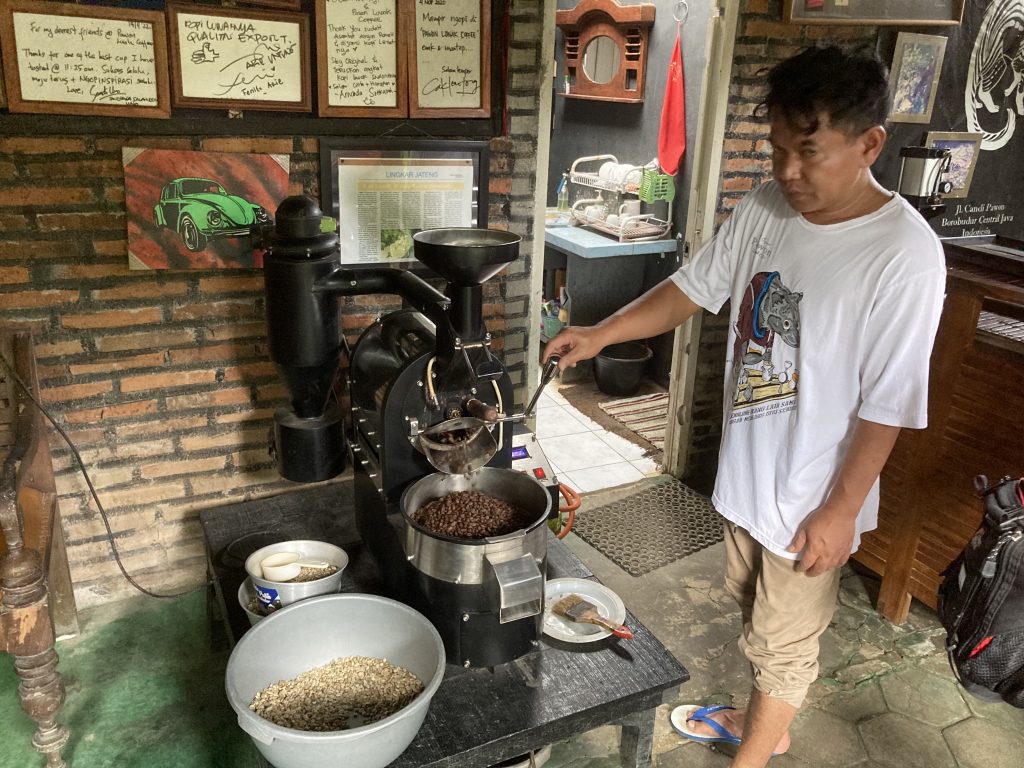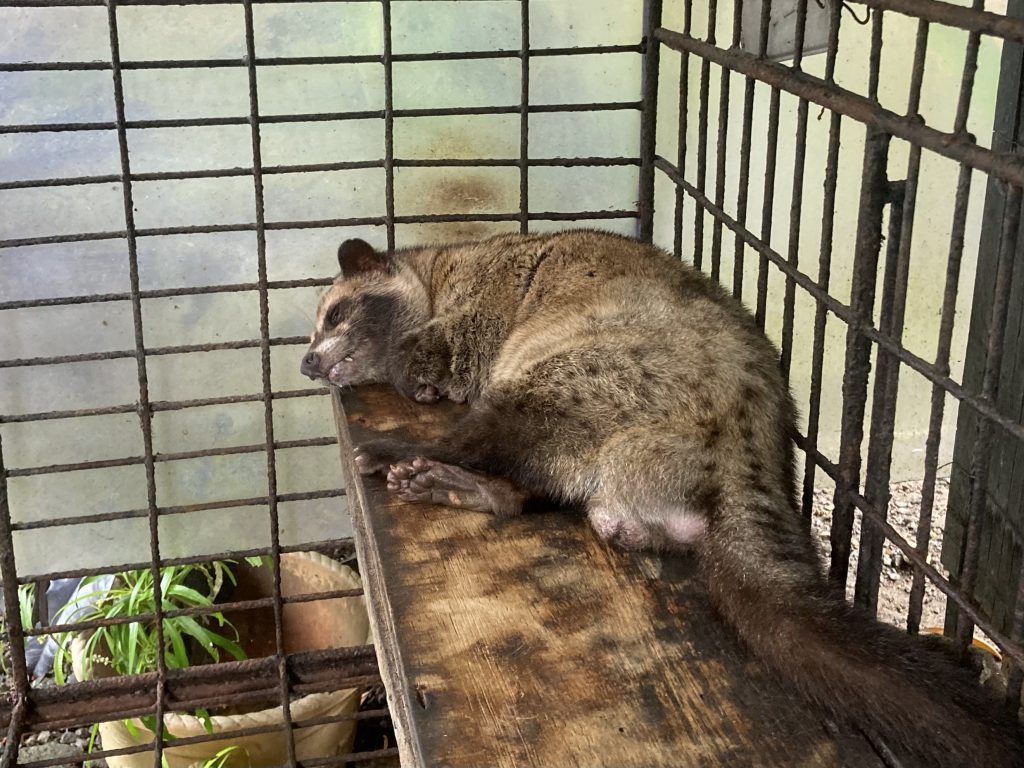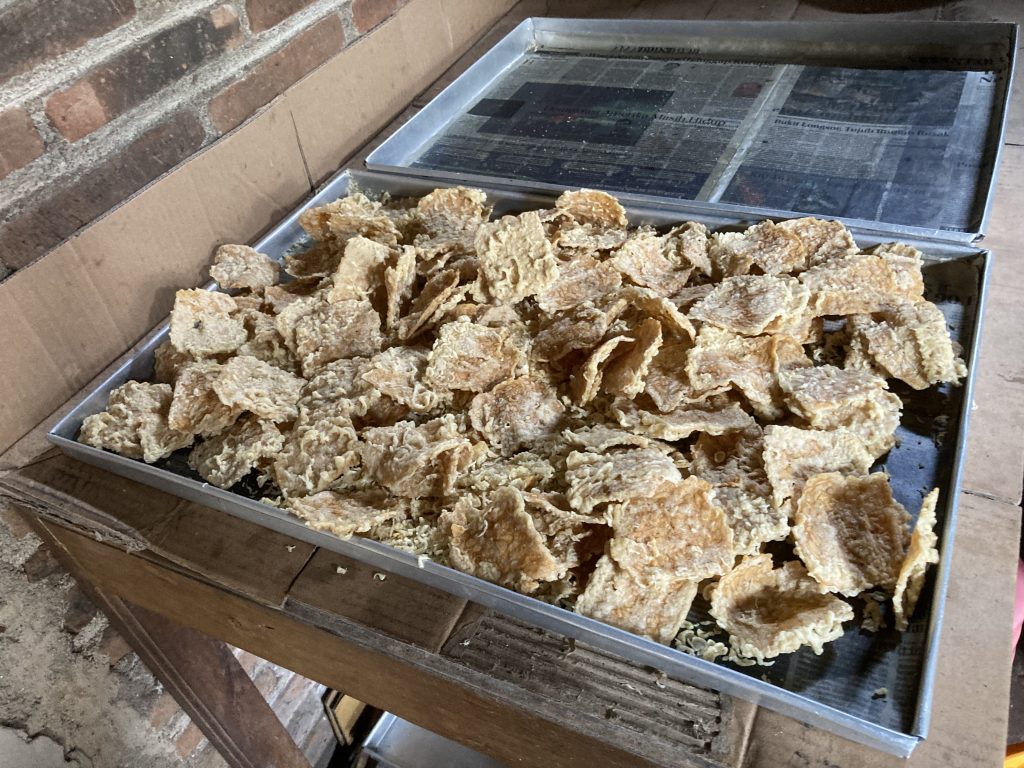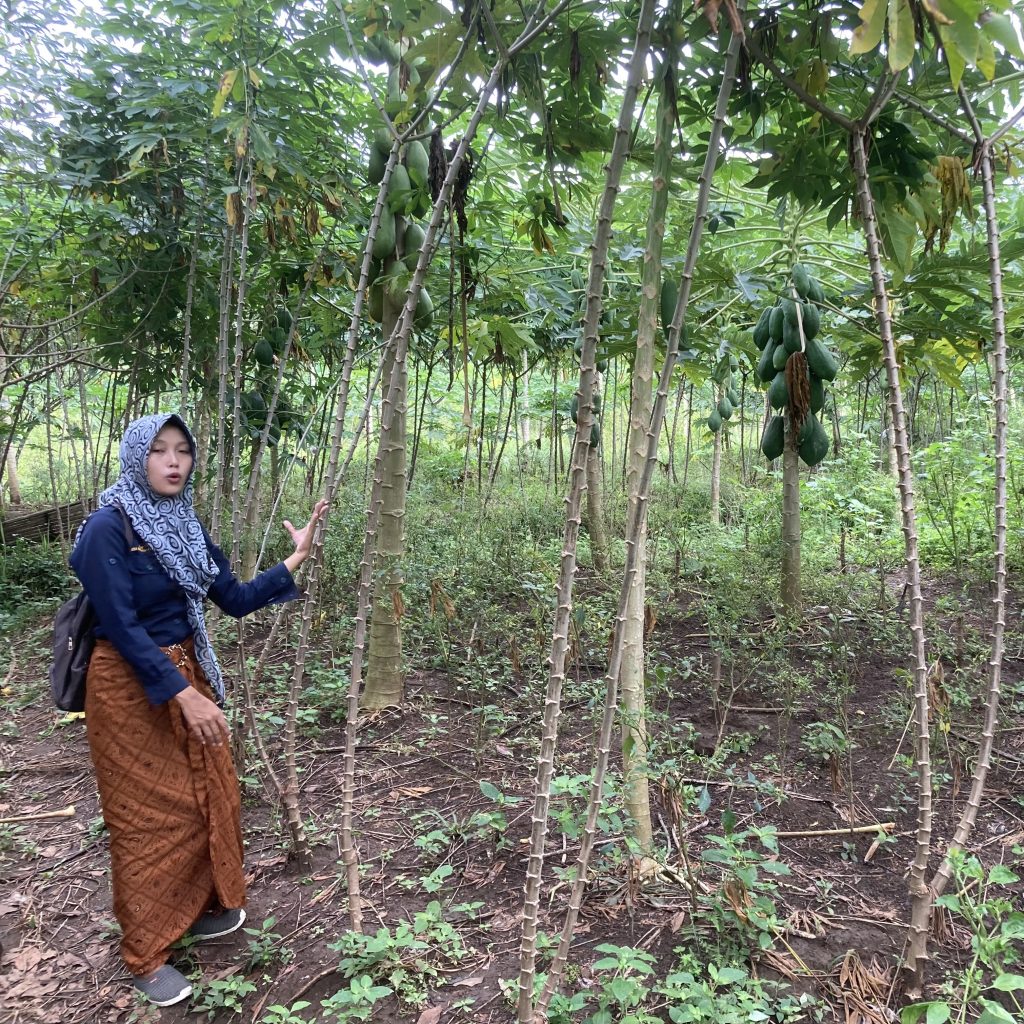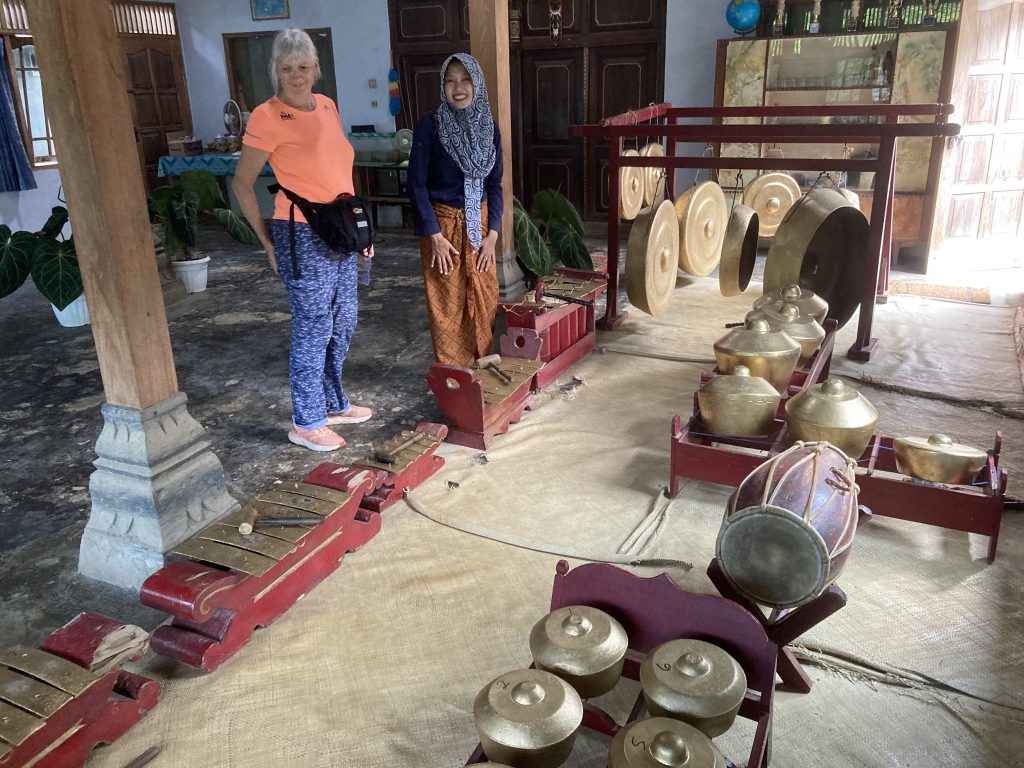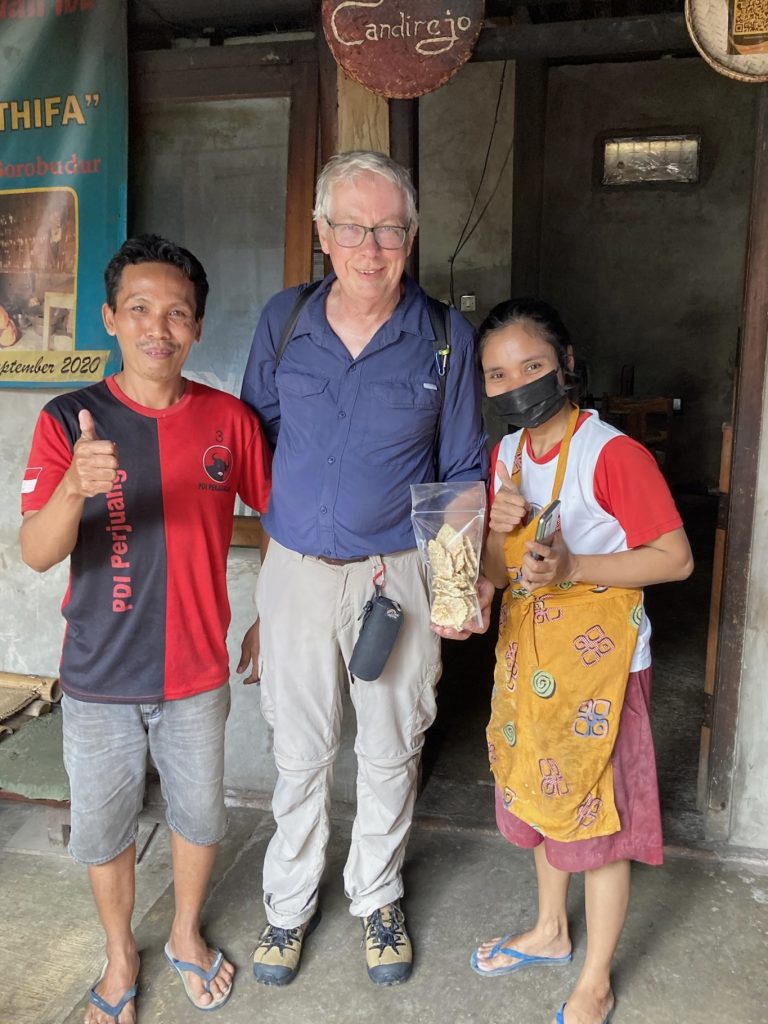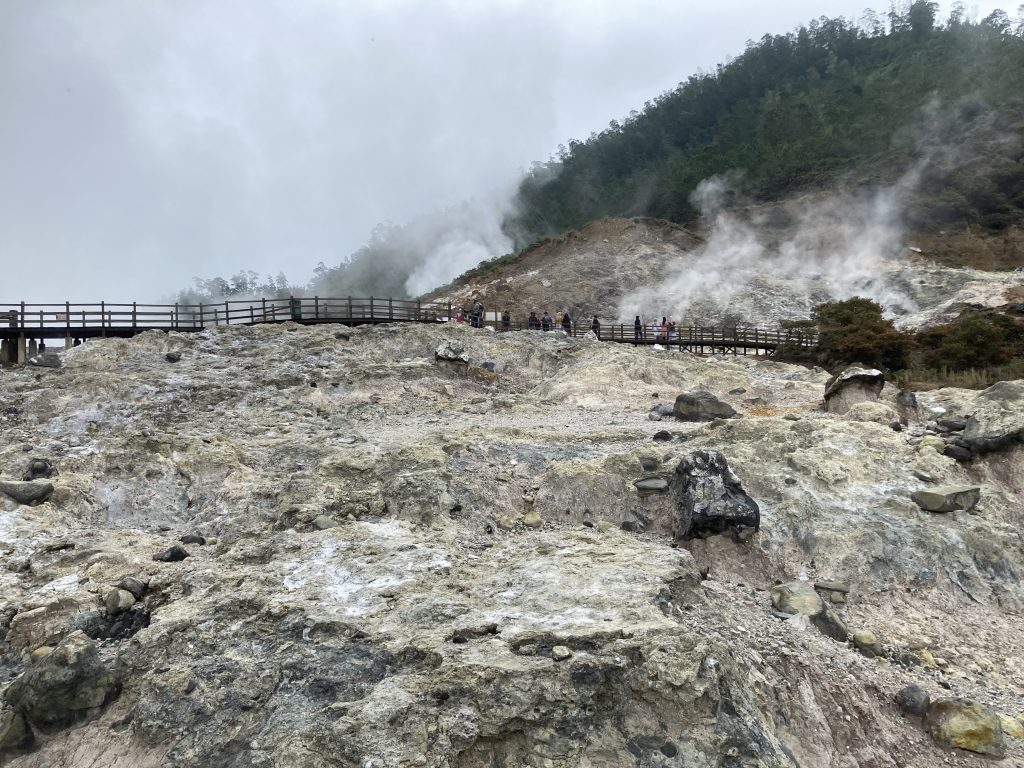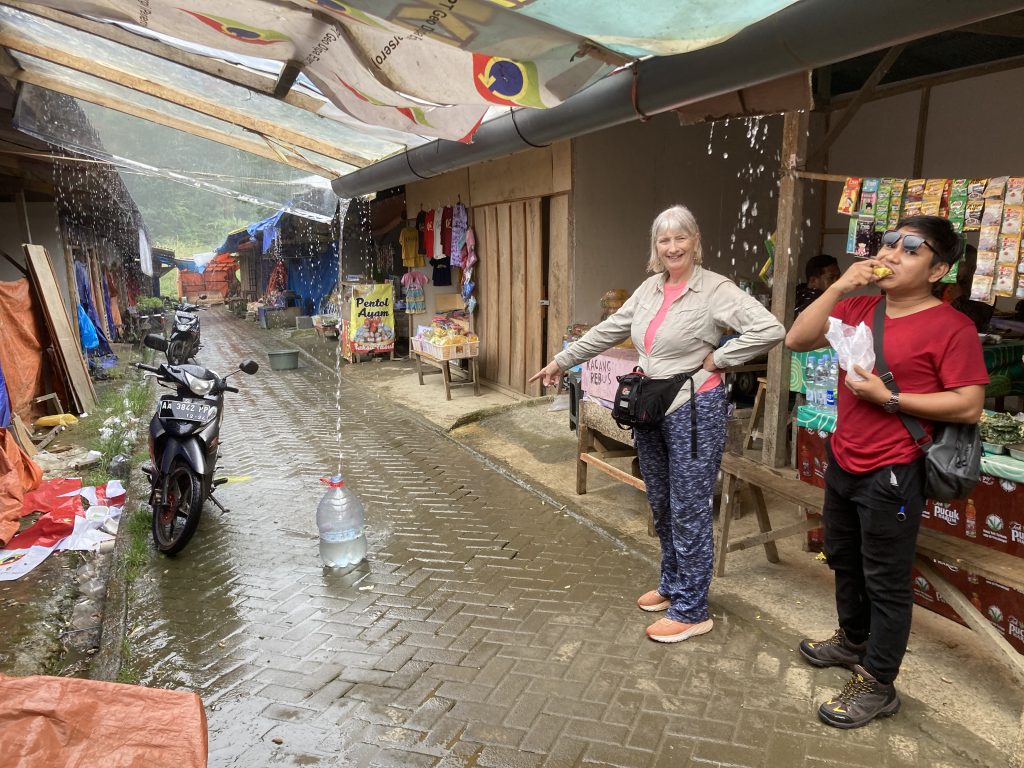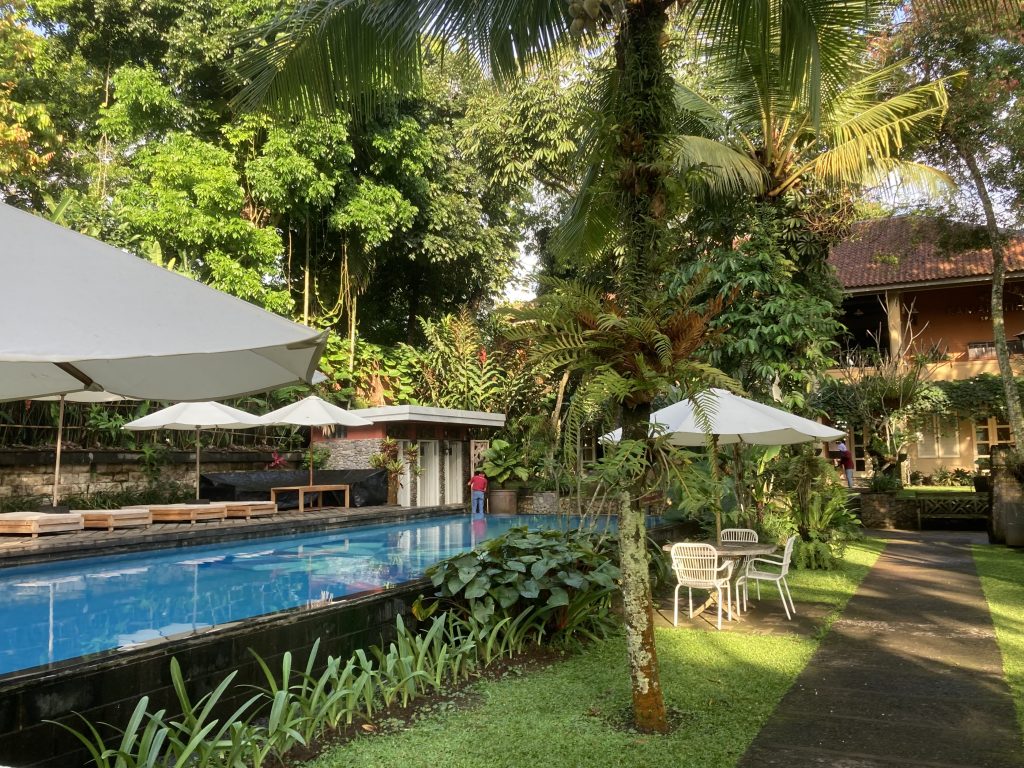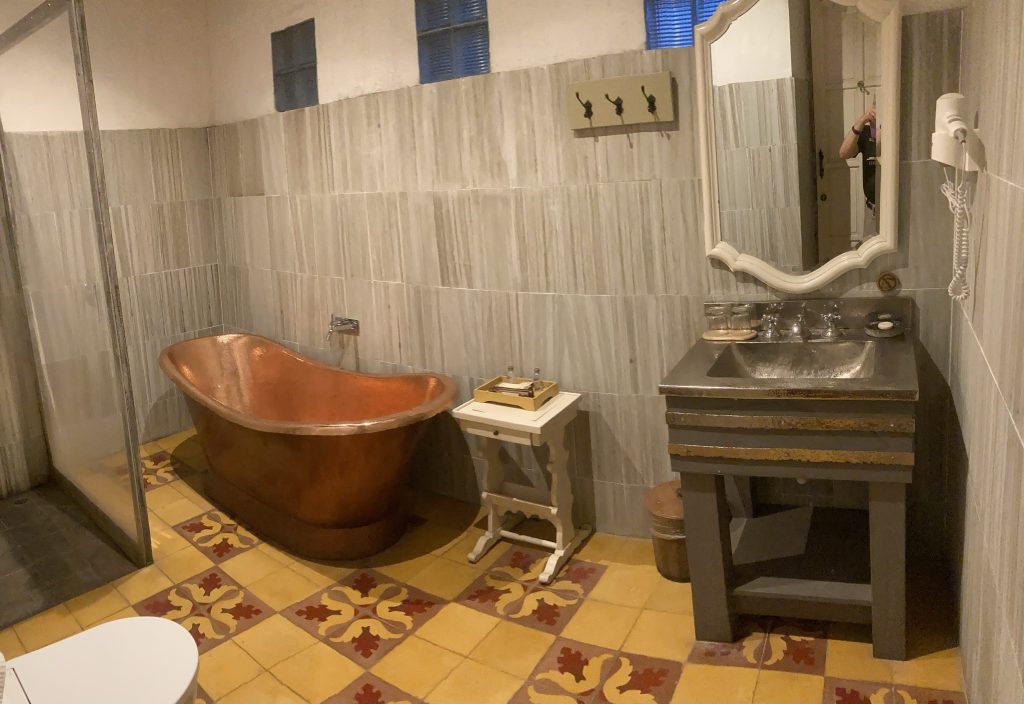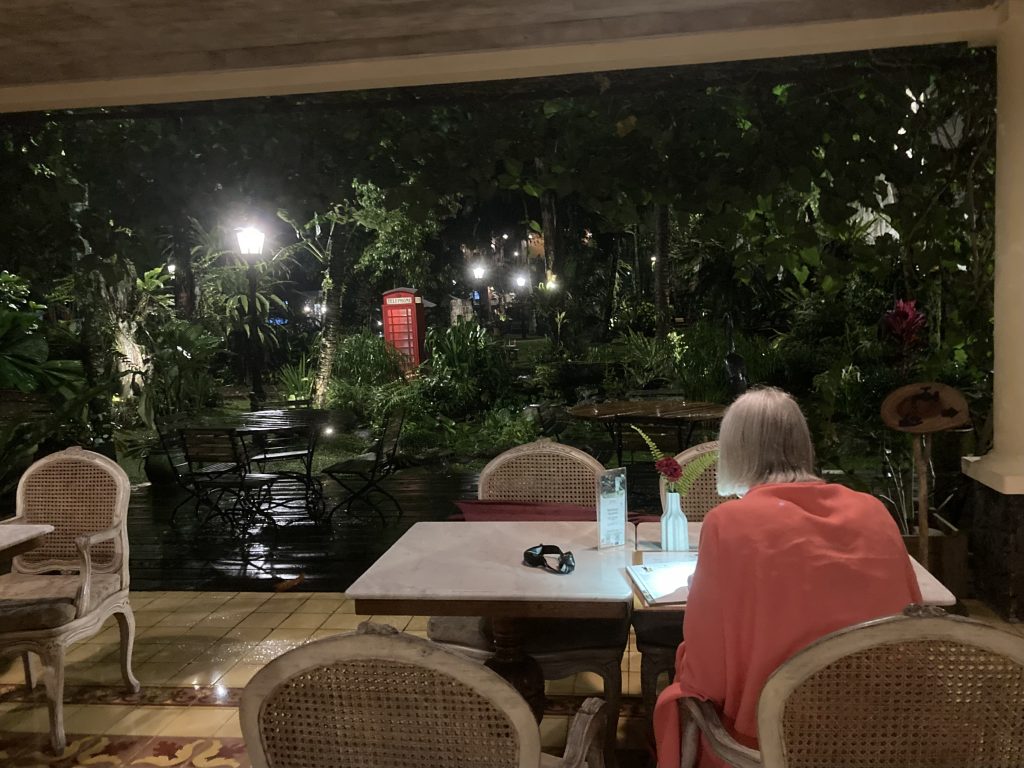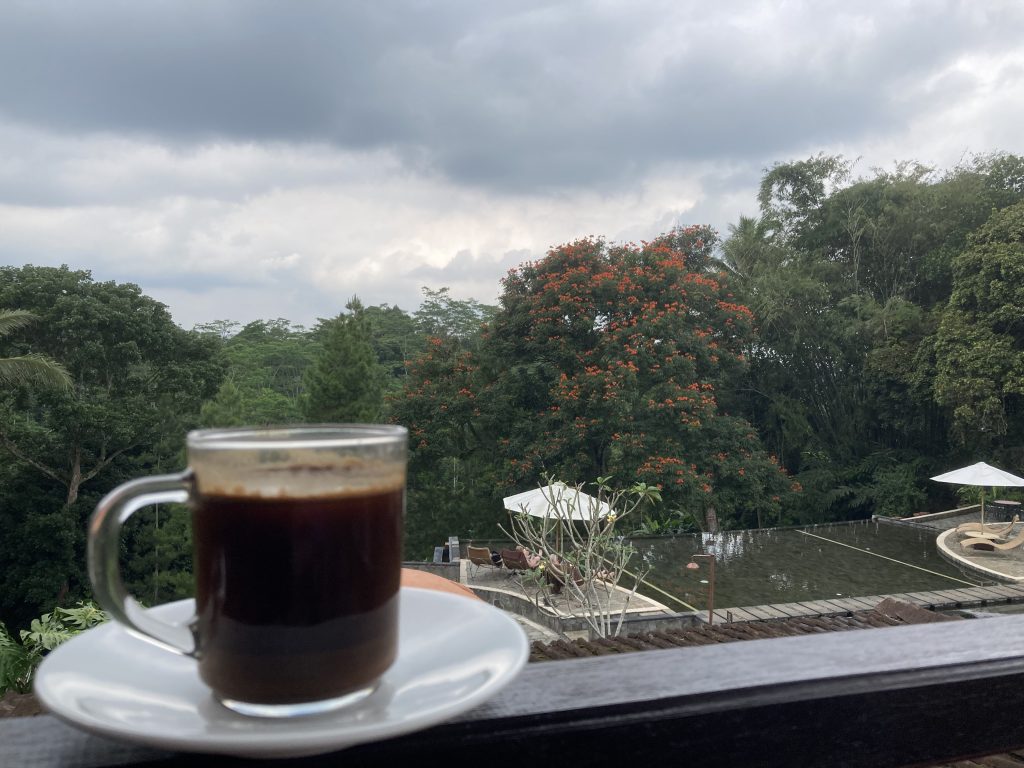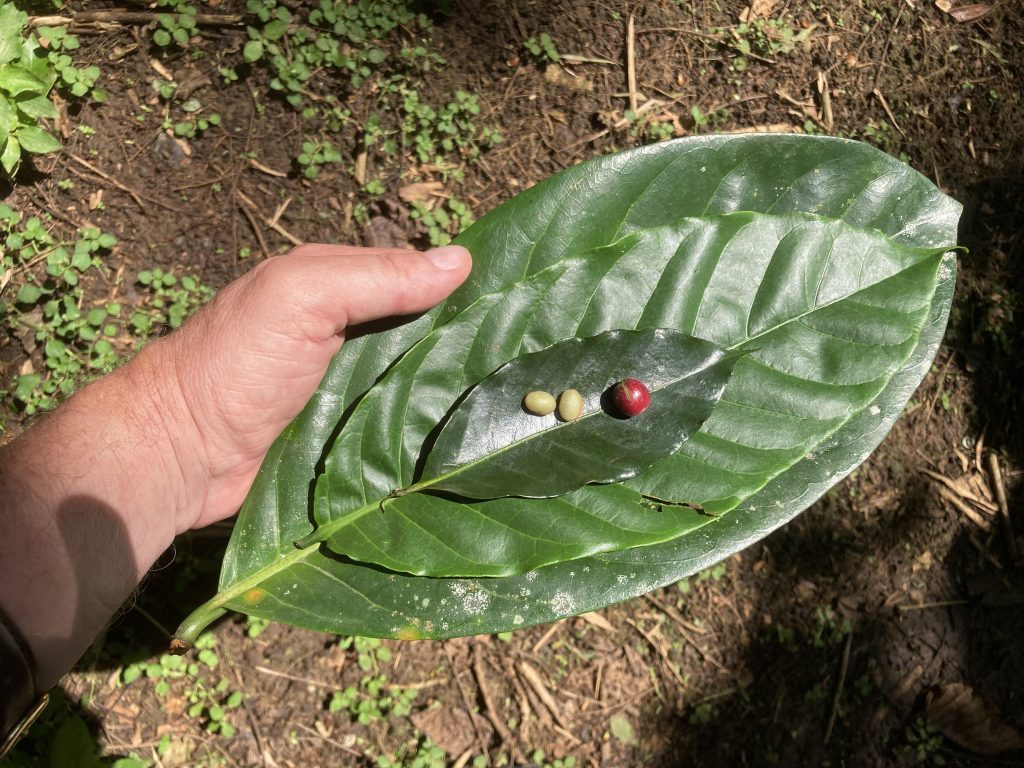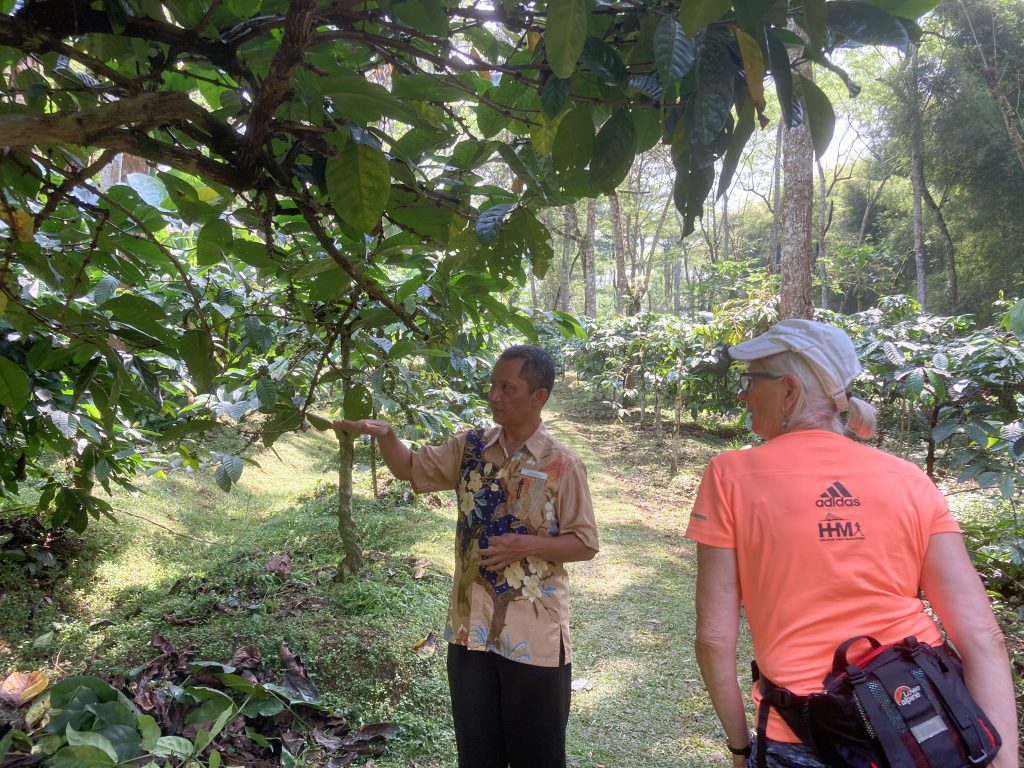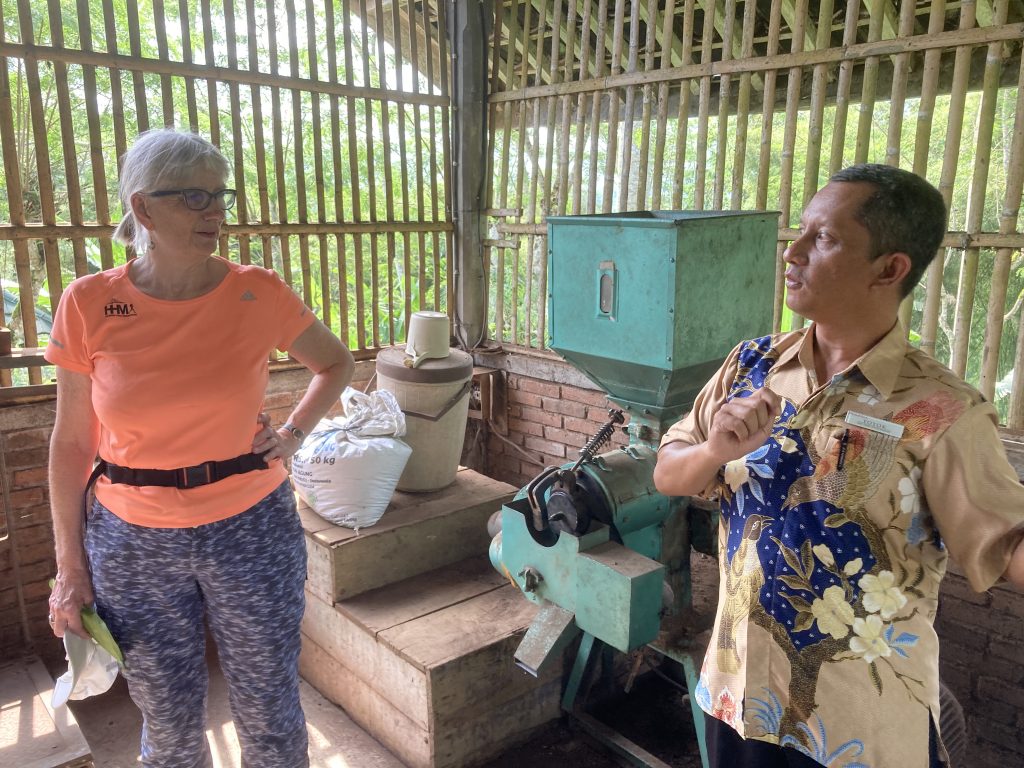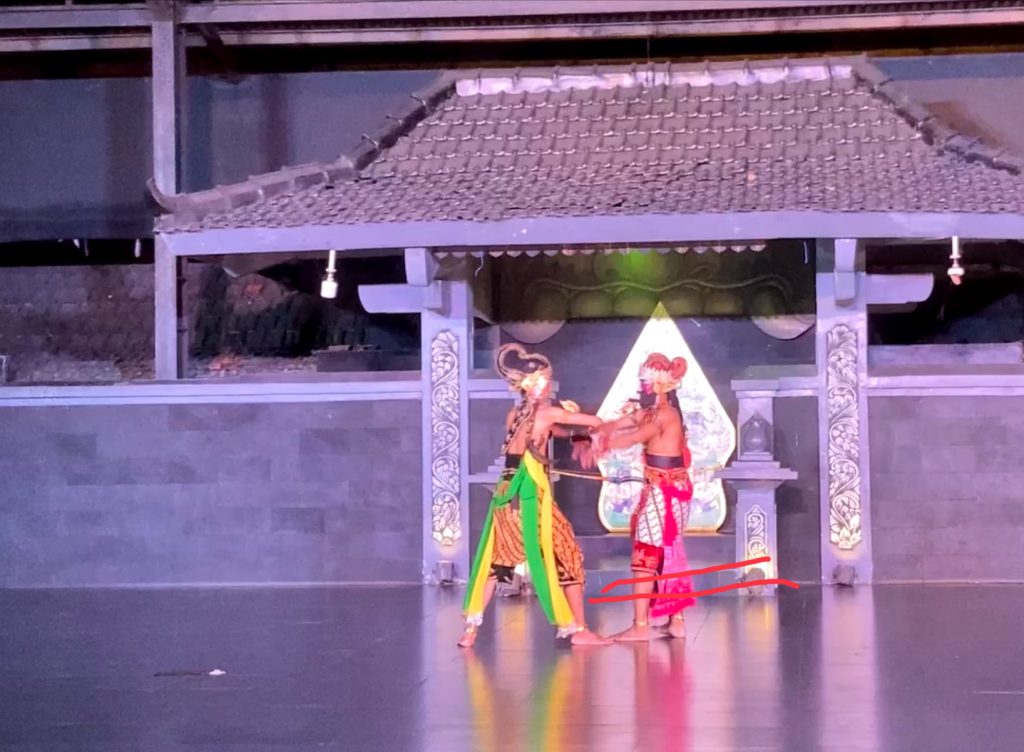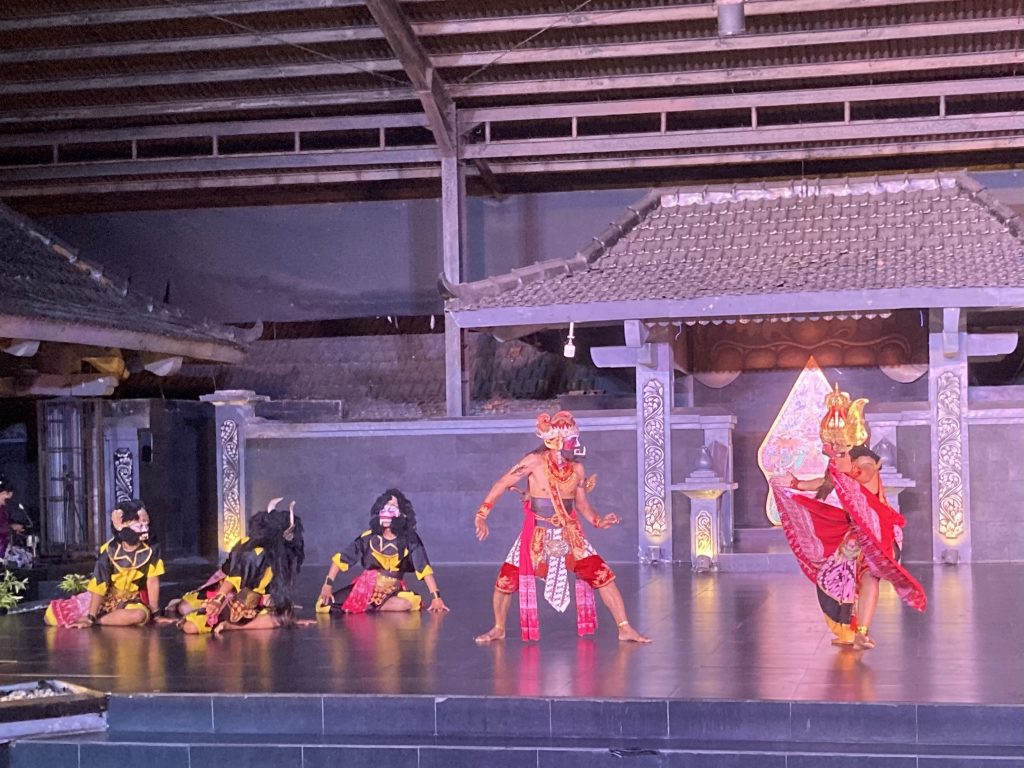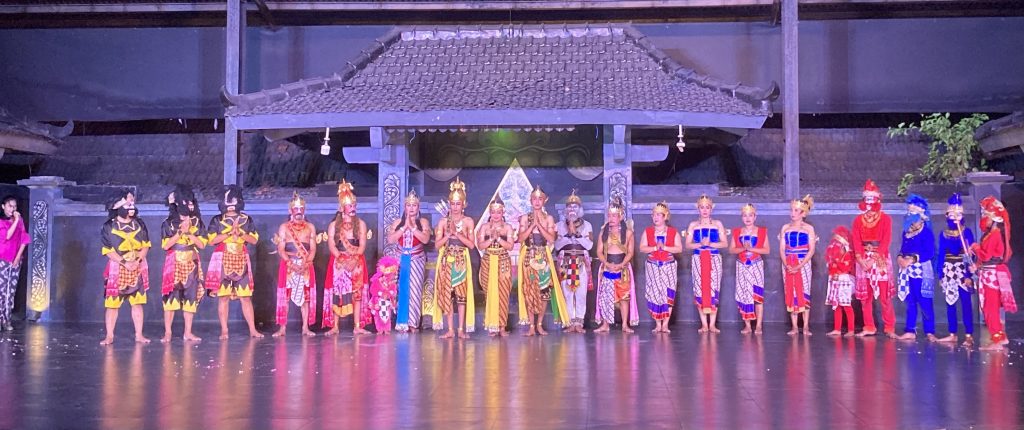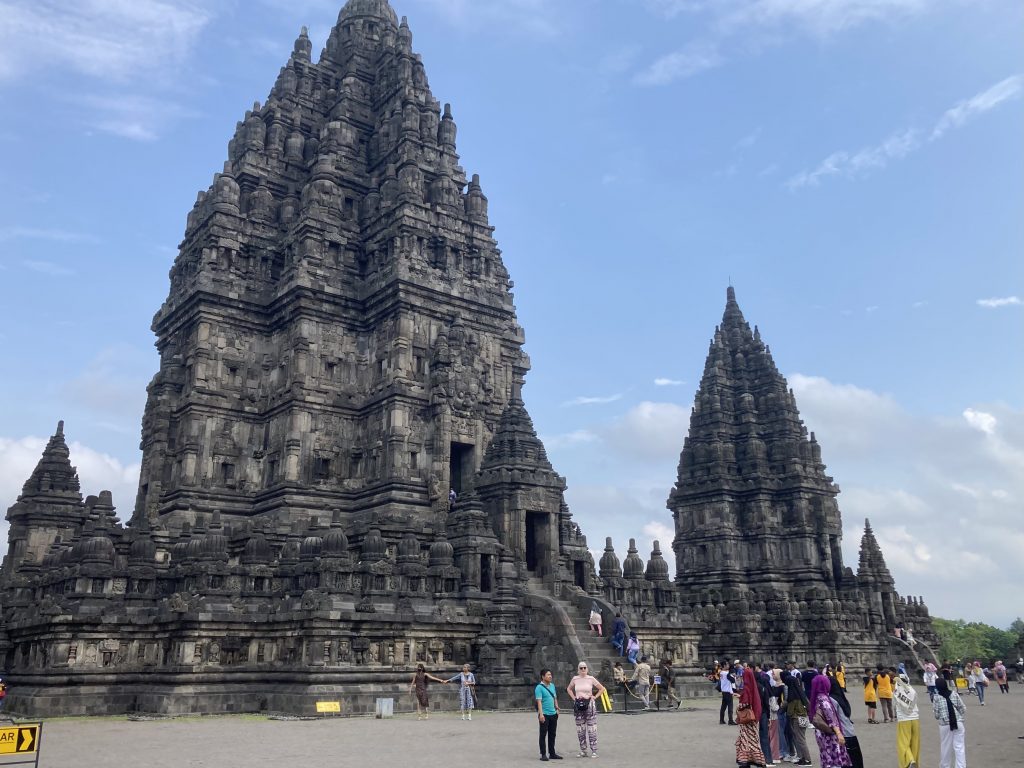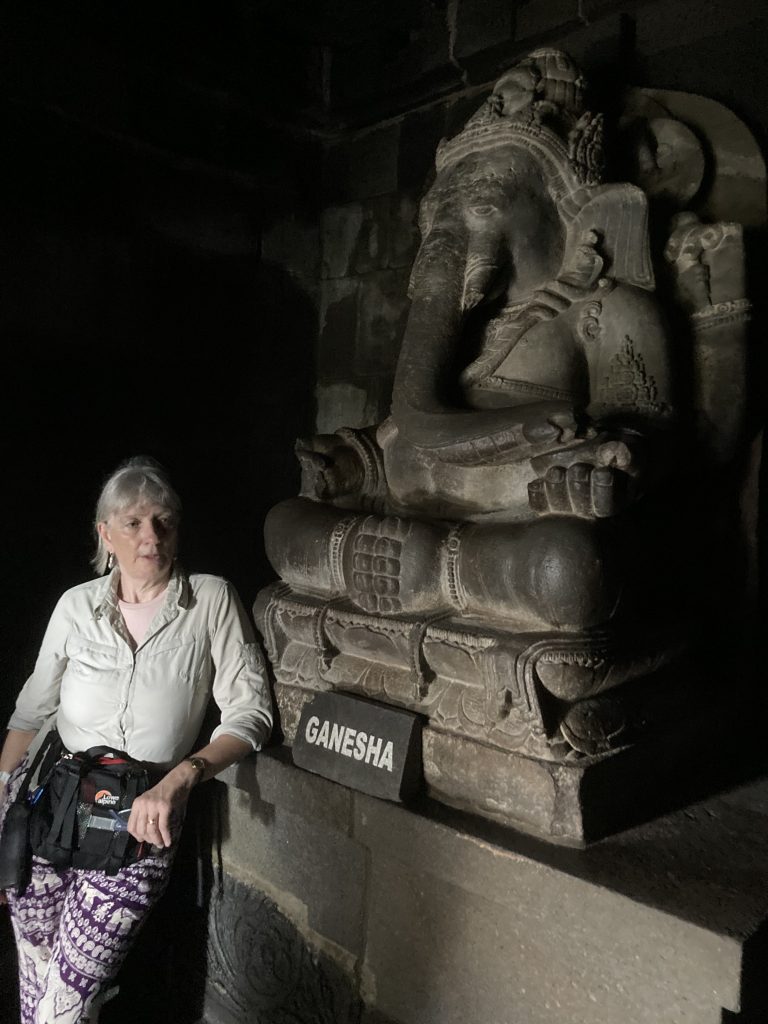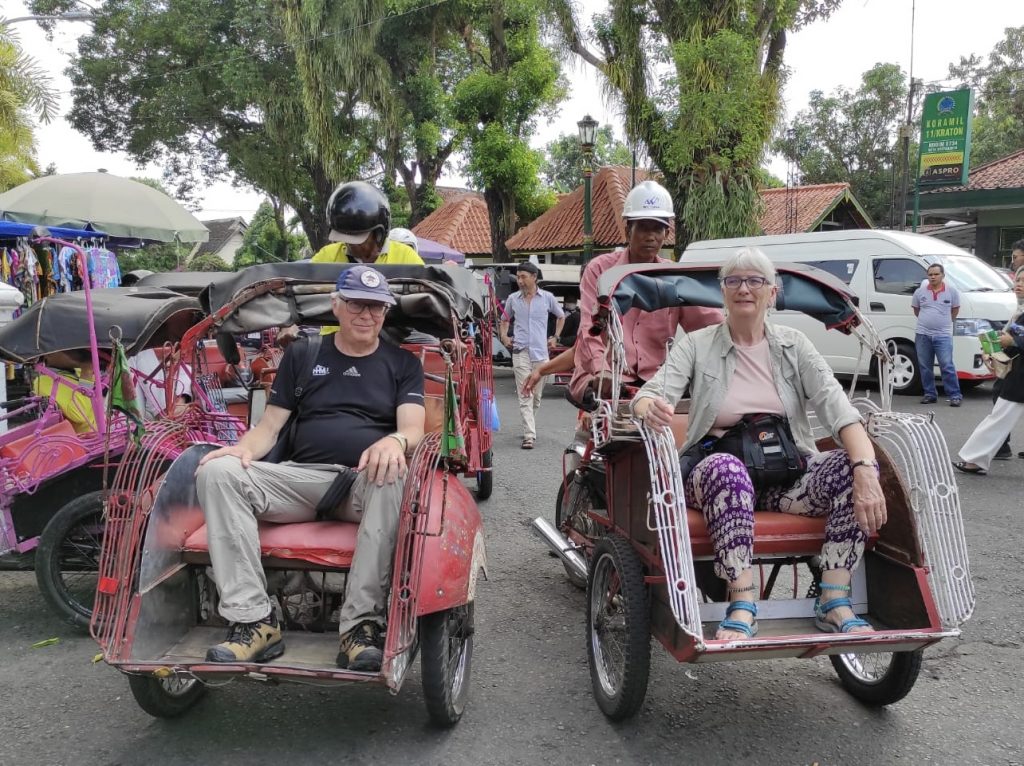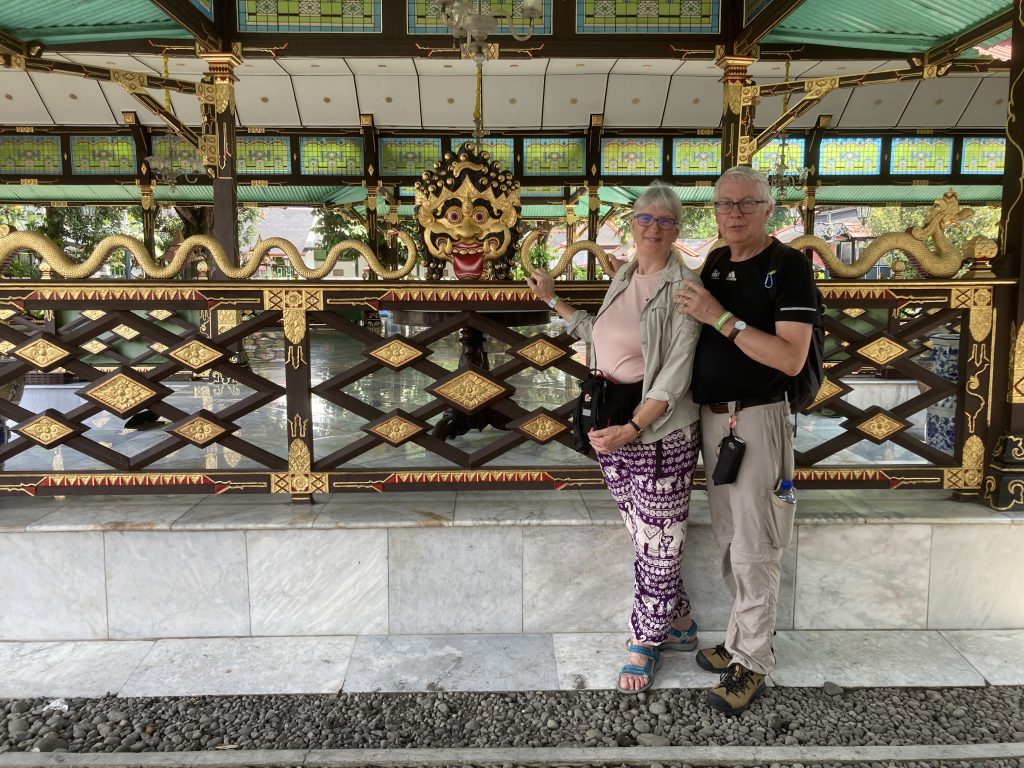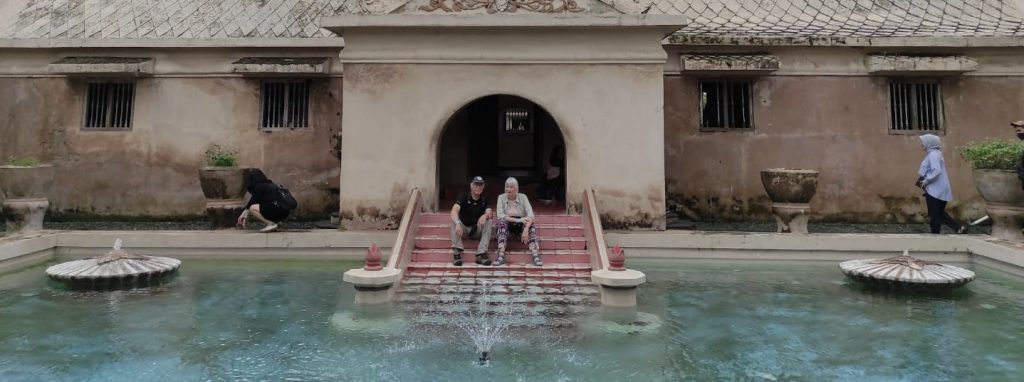2nd – 6th May
Despite our advance agreement as to which exit of the station to meet our guide, finding the exit was quite tortuous. Once we found it though, Roszi and our driver Udi were there waiting for us.
Yogyakarta station has platforms on both sides of each railway track, so when we opened the door on one side there was a steep drop, but steps down to the platform on the other side. That is to allow passengers to walk across to the other platforms, when there is no train on the tracks. As it was we found an underpass.
The skies darkened and we encountered torrential rain on the sixty minute drive to Borobudur where we stayed in a lovely resort hotel.
We had unfinished work to do. This consumed far too much of our energies and anxieties – even employing Kirsten’s assistance to no avail: booking our return tickets on the train from The Grand Canyon.
As we travel, we are also booking hotels, trains, buses and ferries ahead, so plenty to figure out in the days and evenings we have the time, mental space and functioning internet.
We had booked an Amtrak sleeper going from LA to Grand Canyon, and now needed to book the return journey. We must have input all the data a dozen times, only to fail when it came to authorising payment. It had worked when we bought the day before…! Finally Peter was able to connect with an agent over the Chat facility on the website and he was then successful in booking the tickets we wanted, and more importantly making payment.
We were up at 4 am to go to the monumental Bhuddist temple, Borobudur, to watch the sun rise from behind “smouldering volcanoes over the temple“, which we understood could be a highlight of our trip. Unfortunately after all the rain the night before, thick mist obscured the sun and we couldn’t even make out the outlines of the volcanoes.



Borobudur
We sat, uncomfortably crosslegged, enjoying a fantastic breakfast. The history and artwork of Borobudur was presented to a small group of us, at the same time as musicians played evocative music and the breakfast courses kept on coming.
We later enjoyed a walk around the temple, built over 75 years, completed in year 725. Unfortunately Covid rules prevented us from climbing onto any of the nine levels. It was impressive with its architectural symmetry and carvings.
We also visited two smaller temples before stopping at a lovely coffee shop by the second temple, Pawon. There we enjoyed tasting Arabica and Robusta Luwak coffee, made from beans found in the poo of civet cats, who digest the beans whole, but whose digestive juices soften the bitter taste of the coffee. We saw the coffee beans before cleaning and shelling, then being roasted and a couple of civet cats asleep in their cages. Highly recommend coffee, at only £250 per small packet from Harrods….
Next we had a tour of a small farming village, Candirejo, on a horse and cart. This was delightful, shown around by one of the young villagers, seeing the fruit and vegetables they grow for the market, the Tempe being deep-fried in garlic and getting to play the Gamelan. A real treat.

Fresh Tempe! 
Here we grow Papaya 
Play time… 
Hospitable
Back to our hotel to catch up on our sleep and enjoy a swim in the pool, before torrential rain all evening.
The following day was really a travel day to the central highlands of Java. We drove to the Dieng Plateau at 2200m and visited the ruins of the Hindu temples at Arjuna. It was refreshing to be in the relative cool of the mountains and see the hydrangeas, trumpet flowers and pine trees growing there.
We visited volcanic sulphur pools at the Sikidang Crater, reminiscent of Rotorua in New Zealand, but without geysers. Then the heavens opened, and we zig-zagged through the market stalls, leading up to the exit, trying to shelter under whatever cover the tarpaulins offered, dodging the gushing water. We got soaked as, for once, we’d left our rain jackets in the car.

Smell the sulphur 
Soakin’ in the rain…
Our driver negotiated fog, torrential rain and heavy traffic all afternoon until we arrived at a splendiferous Dutch colonial hotel. It was complete with pool, excellent gym facilities, a spa and a red English telephone box! We would have loved to make use of the facilities, but we had an early start and it was already dark and still raining when we arrived. We were the only diners in the restaurant, accompanied by many frogs in the gardens!
Next morning we visited the Gedong Songo Hindu temple complex, climbing up to 1600m to catch a view of the lake. We visited the five main temples, passing sulphurous steam, gushing out of the volcano, one of the 127 active volcanoes in Indonesia. We enjoyed getting some exercise! The site was empty, but really well landscaped with pretty flowers, bushes and trees.
The MesaStile coffee plantation was our next destination, where we received a tour, saw all four coffee varieties grown on Java, and tasted more coffee. Our guide, Mr Yoyok, was keen to tell us about his visit from Michael Portillo, for his series on Asian train journeys, which we had watched. Our contribution to Mr Yoyok was to introduce him to Manhattan Transfer’s song – Java Jive, which he was really delighted to know, not having heard it before.
We had travelled nearly 300 kilometres and were now back in Yogyakarta. Fortunately the roads on Java are of much higher quality than in Sumatra. Such distances would have been impossible there.
A new one for us:- there were men with red flags, directing traffic flow at junctions, with drivers passing over a small bank note through the window as he negotiated the junction. On the other hand, in Sumatra, you would often see local men with a small bucket asking for money to upgrade the road!
Back in Jogja (as it’s known), dinner and a Ramayana ballet, off-site had been arranged. Our expectations both for the buffet dinner and the performance were low, but since Roszi had forewarned the hotel about Lynne’s garlic allergy, they created an impressive spread for her, far superior to the fall-back option of Nasi goreng.
The performance was held on a wide, low apron stage, with a live Gamelan orchestra. The performers, beautifully dressed up, with incredible make-up, enacted a classical story of Ramayana. The Gamelan music is played with an ensemble of brass xylophones, gongs and drums, singing by two classically trained women and a man, augmented by occasional hand clapping and chanting by the performers.
The dancing, enacting the legend, was highly stylised with precise movements – balance, poise, head, hands and fingers – everything precisely controlled. Peter was reminded of the work the famous theatre director Peter Brooks did on non-verbal story telling. He must have learnt a lot from this style of music and dancing.
There was the added excitement of real fire and fireworks on stage and a little girl of no more than five taking part as one of the monkey people. Other performing children enjoyed climbing on the roof above the gamelan players. Drama, pathos and fighting!
Next morning we visited the Hindu temples at Prambanan. It was Saturday and the site was busy. We cannot count the number of children, parents and teachers who clamoured for photos with us. Lynne was keen to respond to the shy giggling girls, in their hijabs, offering to pose with them to boost their confidence.
Enough said – before Lynne starts a polemic on the subject, aggravated by the discourse she received twice about the issue the Sultan of Yogyakarta has with no heirs and only 5 daughters.
The temples were magnificent, the experience enhanced by being allowed to climb the steps and venture inside. The temples with their stories and stone work are reminiscent of Borobudur, which is a Buddhist temple, completed about the same time as work started on the temples here.
We visited the Sultan’s palace, built between 1756 and 1790, where he still lives, and the magnificent swimming pools, “Taman Sari” that one of his ancestors built for his wives and children over 200 years ago. The pools certainly appeared inviting in the heat. An underground mosque, part of the complex, and reached through a tunnel, was still closed to the public. An enjoyable outing, complimented by some excellent coffee and live music near the entrance.
To travel between the sultan’s palace and the water gardens, we used a motorised rickshaw (a wheeled seat, pushed by an underpowered moped) this time where the passengers sit up front.



Sultan’s swimming pool
We resisted more activities, returning to our hotel to spend a relaxing afternoon catching up with our future hotel and travel bookings and iPads. We ventured out to a local Indonesian/Italian restaurant which didn’t disappoint with pasta and pizza – and a couple of welcome glasses of wine.
We are now setting off eastwards, by train early tomorrow morning on our way towards East Java and then onto Bali. The distance between Medan and Bali stretches to 3,000 km, as opposed to the 5,000 km between the extreme ends of the archipelago. We will only have visited three of the more than seventeen thousand islands that make up Indonesia.
